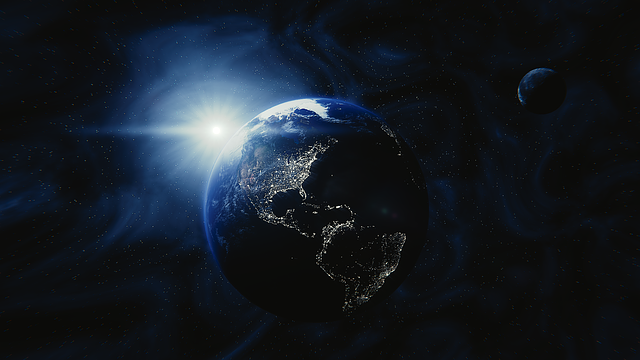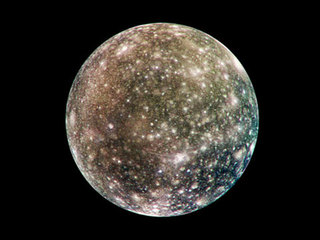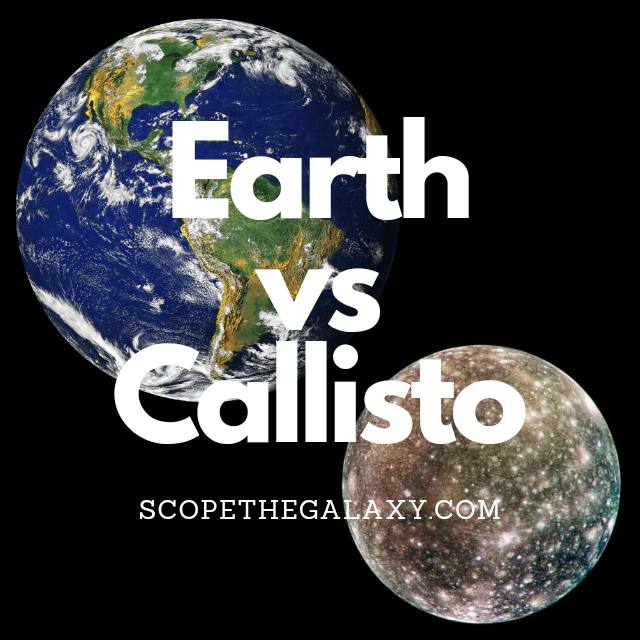*This post may contain affiliate links. This means we may make a commission if you purchase an item using one of our links*
The main differences between Earth and Callisto is that Earth is the 3rd farthest planet from the Sun and the 5th largest planet in our solar system with a diameter of 12,742km whilst Callisto is joint 5th farthest with Jupiter and the 3rd largest Moon in our solar system with a diameter of 4,820.6km, Callisto has more named craters with 142 compared to Earth’s 127 named craters and Earth is able to sustain intelligent life whilst Callisto cannot.
There are numerous other differences between these two entities so, continue reading if you want a more in-depth look at both Earth and Callisto along with their similarities and differences.
What Is The Planet Earth?
Table of Contents

Our home planet Earth is the 3rd farthest planet from the Sun, made up of a mixture of water and solid rock like objects, and is the only entity in our solar system known to allow intelligent life forms like ourselves to exist.
Earth’s distance of 152 million km from the Sun has allowed it to remain within the goldilocks zone and as a result, the planet has been able to thrive for millions of years. It orbits the Sun in a circular pattern, much like all the other planets, has only one natural satellite which would be the Moon and is a terrestrial planet to boot.
In regards to its diameter, Earth is the 5th largest planet with a diameter 12,742km.
Earth’s temperature ranges based on the region you’re located where it can be from as low as -94 degrees Celsius in Antarctica to as high as 50 – 55 degrees Celsius in Tunisia.
As for the planets composition, it consists of the crust, the mantle, the outer core and the inner core, where the inner core is the hottest element within the Earth reaching temperature in excess of 5,200 degrees Celsius.
In regards to some of its most unique features, Earth is around 71% water, has an atmosphere consisting mostly of oxygen and nitrogen that is also made up of 5 main layers, with the highest to lowest being the troposphere, stratosphere, mesosphere, thermosphere and exosphere.
A day on Earth is 24 hours and an orbital cycle around the Sun takes 365 days to complete. It’s axial tilt is more distinct at 23.5 degrees to the right.
What Is The Moon Callisto?

Callisto is one of the large moons orbiting Jupiter, the outermost of the Galilean moons, first discovered on 7th January 1610. The surface of this icy world is frozen, but scientists believe an underground ocean could reside beneath the ice.
Even if there’s water on Callisto, it won’t necessarily hold life because the surface is so old. Scientists will need to conduct more research into the moon before determining whether this is a likely possibility.
The ESA’s JUICE (Jupiter Icy Moon Explorer) mission is focused on the three ice moons of Jupiter. It is expected to arrive in 2030 and will focus on learning more about the environment of each, as well as their potential for hosting life.
Scientists estimate that Callisto is around 4.5 billion years old (the same age as Jupiter), and its average distance from the Sun is approximately 778 million km. It has a diameter of 4820.6km, which makes it similar in size to the planet Mercury, and the average temperature is a frigid minus 139.2 degrees Celsius.
Callisto takes seven days to orbit its planet at an average distance of 1,880,000km, and it is tidally locked, meaning the same side of it always faces Jupiter. But this moon experiences less tidal influence than the other Galilean moons because it lies in the orbit of Jupiter’s primary radiation belt.
The name of this moon is derived from the stories of Greek myth. Callisto was the nymph who had an affair with Zeus, the King of the Gods. Upon hearing this news, Zeus’ wife Hera turned Callisto into a star and placed her in the Ursa Major constellation. Interestingly, every moon of Jupiter is named after a Greek figure who Zeus seduced.
Callisto may be the third biggest moon and similar in size to the planet Mercury, but it only has a mass of 107,593,737,963.819 billion kg. That may sound like a lot, but it’s only ⅓ the mass of the similarly sized Mercury.
You may wonder why scientists classify Callisto as a “moon” rather than a planet if it’s almost the same size as Mercury. The reason is simple; planets must orbit the sun, but Callisto orbits one of the planets.
The composition of this frigid world is around 60% rock and iron and 40% ice. The moon has roughly equal amounts of rock and ice, plus the potential for water below the surface. There are also traces of carbon dioxide, organic compounds, and silicates.
This moon is one of the oldest landscapes in the Milky way and the most heavily cratered body in our system. However, scientists believe this could now be a “dead” moon as there are no longer any signs of volcanism or plate tectonics on its surface.
Similarities Between Earth And Callisto
Callisto and Earth do have their odd few similarities, which in this case includes the below:
- Both have a hotter central core.
- Both have an atmosphere and a rocky surface.
- Both are a spherical shape.
- Both are part of the same solar system.
- Both have no rings surrounding them.
Differences Between Earth And Callisto
In regards to the differences between the two, they include the following:
- Earth is the bigger of the two with a diameter of 12,742km compared to Callisto’s diameter of 4,820.6km.
- Callisto does not have tectonic plates whilst Earth does which means that many would regard Callisto as a dead planet so to speak.
- Earth has a magnetosphere whilst Callisto does not.
- Earth has 1 moon orbiting it whilst Callisto has 0 objects orbiting it.
- Callisto orbits Jupiter in an elliptical pattern whilst Earth orbits the Sun in a nearly circular pattern.
- Callisto is tidally locked to Jupiter whilst Earth isn’t tidally locked to any other object.
- Earth has an atmosphere with 5 main layers whilst Callisto has a very thin carbon dioxide based exosphere.
- Callisto is one of the most heavily catered entities in our solar system whilst Earth has 127 named craters whilst Callisto has 142 named craters with a lot more smaller one scattered throughout the moon.
- A day on Callisto takes 17 days whilst Earth completes a day in 24 hours.
- Earth orbits the Sun in 365 days whilst Callisto orbits the Sun in 12 years and around Jupiter in 17 days
- Callisto’s density is 1.83 g/cm³ whilst Earth’s density is 5.51 g/cm³.
- In regards to their axial tilt, Earth’s is 23.4 degrees whilst Callisto’s is practically 0 degrees.
- Earth’s average temperature is 13.9 degrees Celsius whilst Callisto’s temperature is -139.2 degrees Celsius.
- Earth is able to sustain intelligent life whilst Callisto cannot.
- Callisto has no water cycle whilst Earth does.
- As for mass, Callisto’s is 1.07 x 10^23kg whilst Earth’s mass is 5.972 × 10^24 kg.
Summary
Even though Earth and Callisto do have the odd few similarities such as their terrestrial body, having over 100 craters on their body and being a part of the same solar system.
Nevertheless, whether it be in regards to size, mass, density, atmosphere, their ability to harbor life and more, Earth and Callisto are realistically worlds apart in regards to their overall functionality.

